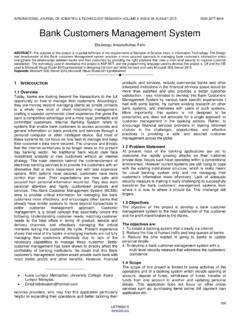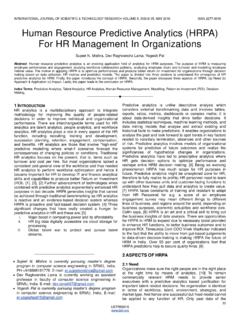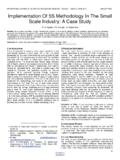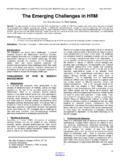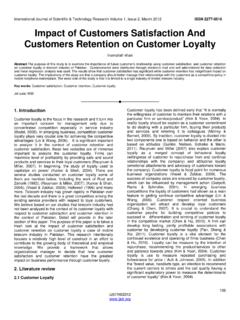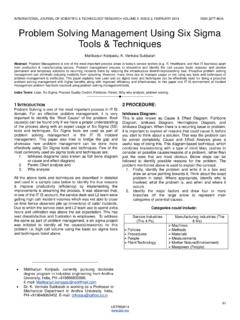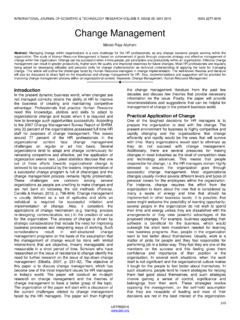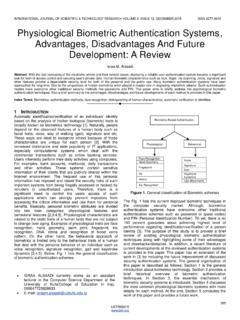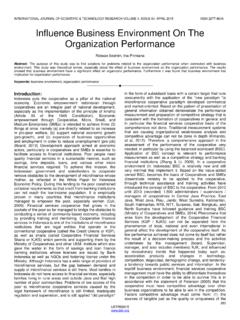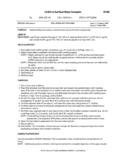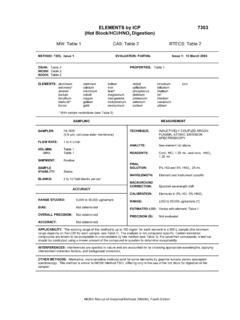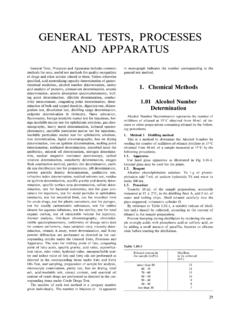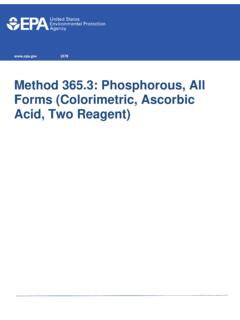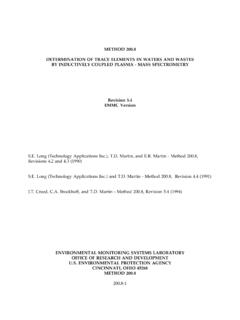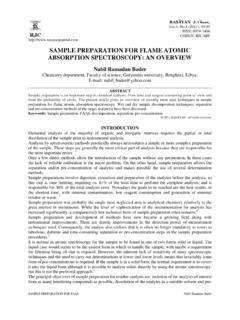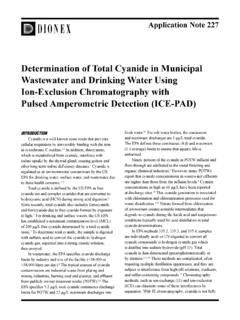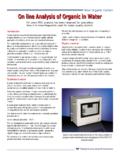Transcription of INTERNATIONAL JOURNAL OF SCIENTIFIC & …
1 INTERNATIONAL JOURNAL OF SCIENTIFIC & technology RESEARCH VOLUME 3, ISSUE 4, APRIL 2014 ISSN 2277-8616 68 IJSTR 2014 determination Of Plant Proteins Via The Kjeldahl Method And Amino Acid Analysis: A Comparative Study. Magomya, D. Kubmarawa, Ndahi, Yebpella Abstract: The amount of protein in most foods is usually determined by multiplying its Kjeldahl nitrogen content by a factor of The reliability of this method in quantitating plant proteins was investigated. Ten lesser known plant leaf samples of nutritional significance among certain populations in Nigeria were used for this study. Protein contents of the plant samples were determined via the kjeldahl method using the conventional nitrogen to protein (N:P) conversion factor ( total nitrogen ) and by summation of amino acid residues (considered more accurate and taken here as the actual protein content).
2 From data of total amino acid and total nitrogen, specific N:P conversion factors were calculated for each sample. The N:P factors ranged from to , with an overall average of Protein contents were also calculated using this new factor. Comparison of the calculated protein contents showed that the traditional conversion factor of overestimated the actual protein content of the samples. The degree of overestimation ranged from 16%-93%. Protein contents calculated with our adjusted factor ( ) gave results that are in good agreement with the actual protein content. Our results indicate that calculation of protein content by N is highly unsuitable for plant samples. Index Terms: Plants, protein, Total Nitrogen (TN), Amino acids, Kjeldahl, nitrogen-to-protein(N:P), conversion factors, 1 INTRODUCTION The protein content of foods is mostly been determined on the basis of total nitrogen content.
3 The Kjeldahl method is almost universally applied to determine nitrogen content, total nitrogen is then multiplied by a factor to arrive at the protein content. This approach is based on the assumption that nearly all of the nitrogen in the diet is present as amino acids in proteins. On the basis of early determinations, the average nitrogen (N) content of proteins was found to be about 16 percent, which led to use of the calculation N x (100/16 = ) to convert nitrogen content into protein content. The use of a single factor, is confounded by two considerations; First, not all nitrogen in foods is found in proteins, nitrogen is also contained in other compounds, such as amides, free amino acids, peptides, nucleic acids, nitrogenous lipids, ammonium salts, nucleotides, nitrates, creatine, choline and secondary compounds [1], [2], where it is referred to as non-protein nitrogen (NPN).
4 Secondly, the nitrogen content of specific amino acids (as a percentage of weight) varies according to the molecular weight of the amino acid and the number of nitrogen atoms it contains (from one to four, depending on the amino acid in question). Amino acid analysis is considered a more scientifically correct way of quantifying proteins. Protein content is calculated as the sum of the amino acid residues (total amino acid minus the mass of water 18g /mol of amino acid). This is sometimes referred to as the true protein . The advantage of this approach is that it requires no assumptions about, or knowledge of, either the NPN content of the food or the relative proportions of specific amino acids - thus removing the problems associated with the use of total N x a conversion factor.
5 Plant materials normally contain significant amounts of non-protein nitrogenaceous substances such as pigments (chlorophyll and phycoerythrin), nucleic acids, free amino acids and inorganic nitrogen (nitrate, nitrite and ammonia) [3], [4] ,[5]. Non-protein nitrogen has been shown to be relatively high in two types of foods (leaves and fruits) [6], [7], [8], [4], [9]. Many studies have consistently demonstrated that plants are generally rich in non-protein nitrogen compounds leading to potentially large errors when using the formula total nitrogen multiplied by It is against this background that this study was carried out to investigate and compare the protein content of plant samples quantified via the Kjeldahl method and amino acid analysis. Ten (10) lesser known plants were used for the study.
6 The specific objectives of this work are to: (i) Compare the results of two methods (Kjedahl method and amino acid analysis) in quantifying proteins in plants (ii) Determine the nitrogen to protein(N:P) conversion for each vegetable. iii) Propose a conversion factor which can be used for routinely converting total nitrogen to protein in similar samples. iv) Determine protein concentrations based on the adjusted N:P factor and compare the results . 2 MATERIALS AND METHODS Collection and preparation of Plant samples: Young tender leaves of Hibiscus cannabinus, Haematostaphis barteri, Sesamum indicum, Balanites aegyptiaca, Cassia tora, Celtis integrifolia Anona senegalensiss, Ceiba petandra, Ficus ingens and Solanum melongena were collected randomly from the wild and farmlands in Adamawa state, Nigeria.
7 The samples were identified by a Taxonomist. Several plants of each species were combined to get representative samples. The samples were washed with distilled water, cut into small pieces, air dried (away from sunlight) and ground into fine powder using porcelain mortar and pestle. determination of Total Nitrogen (Kjeldahl method) 2 g of powdered sample was digested in a Kjeldahl digestion flask by boiling with 20 ml of concentrated H2SO4 and a Kjeldahl digestion tablet ( catalyst) until the mixture was clear. The digest was filtered into a 250 ml volumetric flask and the solution made up to mark with distilled water and connected _____ Magomya, Yebpella Department of Chemical Sciences Federal University Wukari, - Nigeria , Ndahi, Chemistry Department, Modibbo Adama University of technology Yola-Nigeria Magomya Email: INTERNATIONAL JOURNAL OF SCIENTIFIC & technology RESEARCH VOLUME 3, ISSUE 4, APRIL 2014 ISSN 2277-8616 69 IJSTR 2014 for distillation.
8 Ammonia was steam distilled from of the digest to which had been added 50 ml of 45% sodium hydroxide solution. 150ml of the distillate was collected in a conical flask containing 100ml HCl and methyl red indicator. The ammonia that distilled into the receiving conical flask reacted with the acid and the excess acid in the flask was estimated by back titration against NaOH with colour change from red to yellow (end point). Determinations were made on all reagents alone (blank determinations). %Nitrogen was calculated as follows: [(ml standard acid x N of acid) - (ml blank x N of base)] - (ml std base x N of base) x Weight of sample in grams Where N=normality Amino acid analysis Amino acid analysis was carried out according to the method described by Sparkman et al [10].
9 Each sample was defatted by soxhlet extraction with chloroform, methanol mixture (2:1). of each defatted sample was acid hydrolyzed with mL of 6 N HCl in vacuum-sealed hydrolysis vials at 110 C for 22 hours. Norleucine was added to the HCl as an internal standard. The tubes were cooled after hydrolysis, opened, and placed in a desiccator containing NaOH pellets under vacuum until dry. The residue was then dissolved in 5ml of acetate buffer (pH ) filtered through a Millipore membrane ( m pore size) and analyzed for amino acids by loading into the Amino acid analyzer (TSM). Calculation of protein contents and nitrogen-to- protein (N:P) conversion factors. Nitrogen Protein 1 (NP1) was estimated by multiplying the total Nitrogen (TN) by [11]. Amino acid protein (AAP) was calculated as the sum of individual amino acid residues (the molecular weight of each amino acid less the molecular weight of H2O ( 18 g in 1M of each amino acid)).
10 The residue for each amino acid was calculated by multiplying the amino acid value with a corresponding conversion factor, then making a summation of all amino acid residue values for each sample [12].Nitrogen protein 2 (NP2) was calculated as total nitrogen (TN) multiplied by the adjusted (new) N:P factor. The N:P factors were determined for each vegetable as the ratio of amino acid protein (AAP) to total nitrogen (TN) of the sample: N:P factor = AAP/TN [9], [13] ,[14], [15]. The mean of the Calculated N:P factors was taken as the adjusted N:P factor. 3 Results and Discussions The nitrogen content and amino acid residues of the samples are presented in tables 1 and 2 respectively. Table 3 presents the protein contents of the samples: Nitrogen protein 1(NP1) calculated as total nitrogen , amino acid protein (AAP) calculated as sum of the amino acid residues and nitrogen protein 2 (NP2) calculated as total nitrogen ( the new N:P factor).
